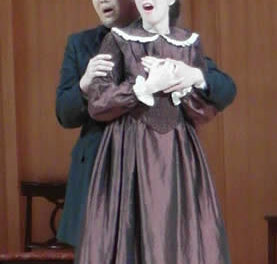To complete a two-week residency (details here) at Duke University, sponsored by Duke Performances, Shen Wei Dance Arts presented a revised version of Shen Wei’s 2006 dance, Re- (Part One) in Reynolds Theater. The piece premiered on that stage in 2006; the full Re- Triptych is scheduled to premiere at ADF 2009, on the much larger stage of the Durham Performing Arts Center. This residency program also included fragments of Re- (Part Two), and a discussion and slide show about the triptych’s sources.
The new Re- (Part One) is substantially different from the original, and generally is much stronger. Shen Wei has doubled the number of dancers to eight, which allows for a far more dynamic choreography, although several sequences were recognizable from the earlier version. You could never call a Shen Wei dance static, but with eight rather than four dancers, the possibilities for massing, spacing, opposition, alliance and exchange are much greater. The work draws on Shen Wei’s physical, visual and spiritual experiences in Tibet, and it still begins on a mandala laid out on the stage floor. Whereas before the mandala was patterned simply in blue and white sand, with a glowing center made of light, now it is made of colored paper shards precisely arranged. Shen Wei made an unsubtle and unsophisticated visual choice here by including in the mandala symbols of the world’s major religions. This kind of literal spelling-out is a disservice to the beautiful abstraction we’ve come to expect from this artist.
Fortunately, the mandala is destroyed by the dancers almost immediately, its shapes and colors evaporated in the rapid mixing of motion. The making and destruction of a mandala is, like a dance, a perfect lesson in Buddhist thought: The ephemeral permanence of change is the one reality; to attach ourselves to any momentary manifestation brings suffering. If we cling to the mandala and mourn its disappearance, we miss the beauty of the next moment, and the ones after, as the dancers inscribe new patterns in the paper duff, in space, and in time. Their actions, the wind of their energy, also sets the paper fragments whirling in the air, to resettle with gravity into new formations independent of the human markings.
Changing from sand to paper in the mandala was useful for that reason, but it was even more beneficial to the purposeful pattern making by the dancers. Watching the lines and arcs appear was like watching cloud-patterned brocade appearing weft by weft on the loom, only much more immediate. To draw like that, by diving and rolling and twisting and rising and sliding, must be wonderful to do — it is certainly wonderful to watch, especially because the surface is never filled, never muddied. Time layers up in the marks, and time is always new and fresh, again and again. The ever-traveling dancers are moving through space, but somehow it is their making contact with the floor point by point that allows you to see in four dimensions: line, plane, space and time simultaneously. Seeing that way, as the musical chanting of Ani Choying Dolma vibrates through your bones, some bright knowledge of the universe fills you. Awkward initial visuals aside, it would be hard to ask more of any artwork.
Re- (Part Two), judging from the fragments shown, bids fair to be even more beautiful. It arises from Shen Wei’s experience of Ankor Wat, and draws on the site’s extraordinary interlocking of human art and natural growth. Much of the carving at Ankor Wat is in the Hindi style, and the sculpted female figures there grace the architecture with sinuous S-curves. In the dance segments presented, company member Joan Wadopian stood out (an unusual thing for this remarkably unified company) for her embodiment of that physical ideal and for the liquid power of her movement.
The triptych’s third section is said to be about China’s future — a sort of projection of what it might become, using the metaphor of the ancient Silk Road. The work, however, is still gestating, and all we saw were photographic images made by Shen Wei in his travels, along with rather too much talk about the putative meaning of the potential artwork. While it was interesting to hear Shen Wei talk, and rather wonderful to be along for the ride as the work develops, it will undoubtedly be far more satisfying to see the completed Re- Triptych in action, unburdened by explanation.











